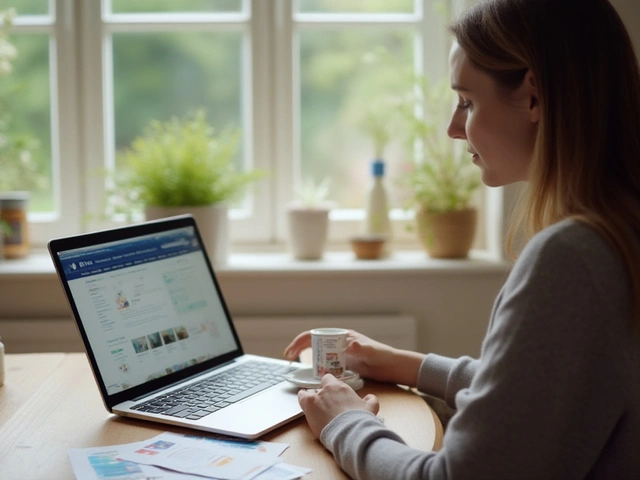The world of women’s mental health treatment sometimes reads like a riddle, so here’s one: what’s marketed as a fix for severe PMS symptoms but hides an old, familiar identity? That’s Sarafem for you. If you’ve ever looked up solutions for sudden mood swings, anger, or crushing sadness right before your period, you’ve probably stumbled onto this name. But the real twist? Sarafem is actually fluoxetine, the same active ingredient in Prozac, just wearing different packaging and targeted at a specific audience. In the late ‘90s, pharmaceutical companies came up with a new plan—let’s take a proven antidepressant and rebrand it for Premenstrual Dysphoric Disorder (PMDD). Seems pretty clever, right? But there’s a lot more hiding beneath the glossy surface.
How Sarafem Works and Its Real-Life Role
Sarafem’s active ingredient, fluoxetine, has been around since the late 1980s. Medically, it’s known as a selective serotonin reuptake inhibitor (SSRI), most famous for its use in fighting depression and anxiety. But in 2000, the same formula got a new mission: easing the symptoms of PMDD, a much more intense form of PMS that can genuinely turn life upside down for a week or so every month. The FDA approved Sarafem for PMDD, and suddenly the marketing machine started churning out pink-and-purple ads targeting women who were fed up with feeling out of control before their period.
What exactly does Sarafem do? At its core, it helps balance serotonin, one of those brain chemicals that plays a big role in mood, anxiety, and overall emotional state. Most people know serotonin as the “feel-good” neurotransmitter. If serotonin levels drop too low, especially at certain points in the menstrual cycle, it can trigger irritability, anger, overwhelm, and even hopelessness. That’s the target zone for Sarafem. By helping keep serotonin available for longer, Sarafem aims to take the edge off those darker moments that feel completely out of your hands.
The numbers also paint an interesting picture. PMDD affects anywhere from 3% to 8% of women who menstruate, according to the American Psychiatric Association. That’s less common than regular PMS, but it’s still millions of people. In a clinical trial funded by Eli Lilly (the makers of both Sarafem and Prozac), women with PMDD saw a significant reduction in mood symptoms. One meta-analysis published in the Journal of Clinical Psychiatry in 2020 found that fluoxetine is about 60% effective at reducing the heavier PMDD symptoms—things like severe anger, mood swings, and anxiety—compared to 30% for those on placebo.
Sarafem is usually prescribed in doses ranging from 10mg to 20mg, taken daily or sometimes only during the luteal phase—the two weeks leading up to a period. That flexibility allows some women to avoid taking medication all month long, easing concerns about ongoing side effects. And since it’s just another branded fluoxetine, most insurance companies will cover it as a generic, which definitely helps with the cost.
Here’s a quick breakdown of how Sarafem stacks up to other options often considered for PMDD and severe PMS:
| Medication | Main Use | Effectiveness (PMDD Symptom Reduction) | Common Side Effects |
|---|---|---|---|
| Sarafem (fluoxetine) | SSRIs, for PMDD & Depression | ~60% | Insomnia, nausea, fatigue, sexual dysfunction |
| Yaz (drospirenone & ethinyl estradiol) | Birth Control + PMDD | ~48% | Weight changes, headache, breast tenderness |
| Zoloft (sertraline) | SSRIs, for PMDD & Depression | ~60% | Dry mouth, dizziness, sleep issues |
| Calcium/Vitamin B6 | Supplements for PMS | ~17-20% | Stomach upset (rare) |
One little-known nugget: When Sarafem first came out, some critics accused the makers of “pinkwashing”—that is, trying to trick women into thinking they needed a new drug for a very old problem, which was actually just Prozac with a new paint job. But for plenty of women, the results meant finally getting a break from unpredictable, life-interrupting symptoms. The controversy didn’t stop doctors from writing prescriptions, and it didn’t stop satisfied patients from speaking up about how much it helped them feel more like themselves each month.

Potential Side Effects, Risks, and What to Watch For
No magic pill comes risk-free. Just like any other antidepressant, Sarafem packs a list of possible side effects, and some are more common than others. The most frequent complaints are things like insomnia, headaches, upset stomach, fatigue, and sometimes a hit to your sex drive. Many people experience these only at the start, and they may fade in a few weeks, but some side effects can linger. For women taking Sarafem just during the days leading up to their period (rather than all month), some symptoms feel milder or less bothersome, but that doesn’t hold true for everyone.
Sexual side effects are the real sticking point for some. Loss of libido, trouble reaching orgasm, or changes in arousal may show up for up to a third of users. It’s not a universal story, but it’s worth knowing upfront so you can track changes and talk with your doctor if things aren’t feeling right. Don’t hesitate to ask for adjustments (like lowering the dose or switching to a different SSRI) if this becomes a deal-breaker.
Weight changes are often a concern, too. Most studies don’t show dramatic gains, but a small portion of people notice a few extra pounds after a few months. The scale might feel less friendly if you’re also struggling with PMS cravings, but it usually evens out with some awareness.
One risk that gets a lot of attention is the rare but possible occurrence of serotonin syndrome—where too much serotonin floods the system. This is more likely if you’re taking other serotonin-boosting drugs, like some migraine meds (triptans) or certain supplements (like St. John’s Wort). Symptoms look like confusion, heavy sweating, high fever, and sometimes muscle jerks. While rare, it’s an emergency, so if you notice a strange cluster of these, it’s time to call for help.
Another group that needs extra caution: anyone under 25, especially teens. Antidepressants sometimes increase the risk of suicidal thoughts in younger users. It’s a rare effect, but the FDA warns about it, so doctors will usually keep a closer eye on any mood changes early on. Don’t go silent if you feel darker or more agitated than usual in the first few weeks—that’s something to talk about ASAP.
Mixing Sarafem with alcohol isn’t usually a great idea, either. Both can deepen fatigue or interfere with judgment, so if you notice worse mood changes or just feel out-of-it, consider cutting back on alcohol while you’re on the medication.
For pregnant women or those trying to conceive, it’s a trickier story. Sarafem and other SSRIs cross the placenta. Most research shows they’re not major risks, but there have been some reports of newborns with temporary withdrawal symptoms if exposed late in pregnancy. Always loop in your OB-GYN before making changes if you’re planning a family.
Curious about actual user experiences? Here’s a list of tips real users recommend to make Sarafem less of a bumpy ride:
- Start low, go slow: Begin with a lower dose, then increase if needed (with your doctor’s okay).
- Take it at the same time each day to keep blood levels steady.
- Give it a few cycles; the first month may not feel miraculous, but things often get smoother by cycle two or three.
- If you feel extra jittery in the morning, try switching to evening dosing (or vice versa).
- Keep a symptom diary—note dates, mood shifts, side effects—so you can spot real trends.
- Don’t mix with herbal supplements for mood unless your doctor okays it.
- If sexual side effects pop up, bring it up at your next visit—there are ways to tweak things.
- Ask your doctor about on-off dosing if you only have trouble during certain weeks.

What to Expect: Tips, Alternatives, and Real-World Advice
If you’re considering Sarafem, you’re probably at the end of your rope with regular PMS hacks—hot packs, chamomile tea, even dietary tweaks like cutting out caffeine or salty foods. For people with PMDD, mood changes aren’t just minor annoyances. We’re talking about tearfulness that starts out of nowhere, fights with loved ones nobody can explain, and a huge drop in energy and self-worth that makes simple tasks feel impossible. If that rings true, and if nothing else seems to help, Sarafem could be worth a genuine shot.
Start by getting an actual PMDD diagnosis, not just self-diagnosed PMS. The difference comes down to severity, timing, and the noticeable lift in your mood once your period actually starts. Document your symptoms for two or three months—lots of people use apps these days, but a good old notebook works just as well. Bring this record to your doctor, who will likely rule out thyroid or other conditions that can mimic mood disorders.
Sarafem isn’t the only route. Some women do well with other SSRIs, such as sertraline (Zoloft) or paroxetine. Oral contraceptives, like Yaz, can also help by stabilizing hormone swings (though they come with risks of their own, like blood clots). Non-medication options, like cognitive behavioral therapy, regular exercise, and making sure you get enough vitamin D, can stack up results if used consistently, too. A good tip: often, what helps the most is some combination—lifestyle tweaks plus medication can get much better traction than either alone.
When it comes to the emotional roller coaster, the brain likes routine. If you stick to a regular sleep pattern, balanced meals, and carve out moments for movement or stress relief (even if that’s just walking or dancing around your kitchen), you’ll give Sarafem its best shot at doing its thing. Skipping doses or taking it at random times only muddies the waters and makes it harder to judge what’s really helping.
Don’t expect immediate results. Most women start to notice a difference in the second or third cycle—suddenly, you make it through a week that would’ve been catastrophic with just a few bumps. The little stuff (like a quick temper or foggy head) gets easier to spot and handle. But be patient; if things feel worse at first or don’t improve by month three, it might be time to talk about other options.
A final, honest heads-up: Sarafem won’t erase all emotional rough patches. Life is still stressful, and hormones are wild. But for many, it evens out the sharp spikes so you can get through the month without the sense that you’re losing yourself once every 28 days. If you’re trying to decide, lean on your support system, get a doctor you trust, and go in with realistic expectations. Sarafem can be a real game-changer if PMDD has you feeling stuck, but it’s not a cure for everything. You’ve got power—and knowledge—at your fingertips now. Use it to get back the days you’re missing.







Jeff Hershberger
July 2, 2025 AT 17:08